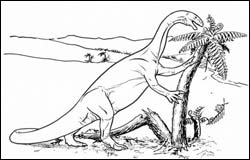Norway’s First Dinosaur discovered – 2256 metres below the seabed

Norway’s first dinosaur fossil is a Plateosaurus, a species that could be up to nine metres long and weigh up to four tons. It lived in Europe and on Greenland 210 to 195 million years ago, at the end of the Triassic Period.
While most nations excavate their skeletons using a toothbrush, the Norwegians found one using a drill.
The somewhat rough uncovering of Norway’s first dinosaur happened in the North Sea, at an entire 2256 metres below the seabed. It had been there for nearly 200 million years, ever since the time the North Sea wasn’t a sea at all, but an enormous alluvial plane.
It is merely a coincidence that the remains of the old dinosaur now see the light of day again, or more precisely, parts of the dinosaur. The fossil is in fact just a crushed knucklebone in a drilling core – a long cylinder of rock drilled out from an exploration well at the Snorre offshore field.
Norway’s first dinosaur fossil is a Plateosaurus, a species that could be up to nine metres long and weigh up to four tons. It lived in Europe and on Greenland 210 to 195 million years ago, at the end of the Triassic Period.
The Plateosaurus at the Snorre offshore field had a hollow grave. The fossil, which was found 2256 metres below the seabed, represents the world’s deepest dinosaur finding. But it is by no means certain that the record-breaking knucklebone is a rarity down there in the abyss.
In fact, the old North Sea land was once a huge area where big rivers meandered through dry plains. Now the landscape has been compressed to form a pattern of fossil alluvial sand between banks of red shale.
Media Contact
More Information:
http://www.nhm.uio.noAll latest news from the category: Earth Sciences
Earth Sciences (also referred to as Geosciences), which deals with basic issues surrounding our planet, plays a vital role in the area of energy and raw materials supply.
Earth Sciences comprises subjects such as geology, geography, geological informatics, paleontology, mineralogy, petrography, crystallography, geophysics, geodesy, glaciology, cartography, photogrammetry, meteorology and seismology, early-warning systems, earthquake research and polar research.
Newest articles

Magnetic Memory Unlocked with Energy-Efficient MRAM
Researchers from Osaka University introduced an innovative technology to lower power consumption for modern memory devices. Stepping up the Memory Game: Overcoming the Limitations of Traditional RAM Osaka, Japan –…

Next-Level System Security: Smarter Access Control for Organizations
Cutting-Edge Framework for Enhancing System Security Researchers at the University of Electro-Communications have developed a groundbreaking framework for improving system security by analyzing business process logs. This framework focuses on…

How Microbial Life Shapes Lime Formation in the Deep Ocean
Microorganisms are everywhere and have been influencing the Earth’s environment for over 3.5 billion years. Researchers from Germany, Austria and Taiwan have now deciphered the role they play in the…



